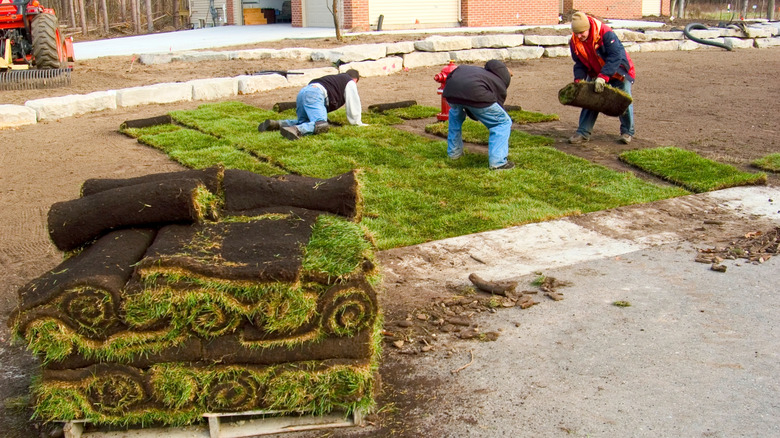What Is Sod And Is It The Right Choice For Your Lawn?
Growing the perfect lawn can be a challenge. Weeds, bare spots, pests, soil composition, and diseases can all get in the way of a lush green outdoor space. Some homeowners turn to sod as the solution to their lawn problems. Landscapers and businesses like golf courses and sports arenas also often prefer sod to seeding turf themselves. That's because sod is an already mature lawn, grown and cared for in sod farms for a year or two. Great pains are taken to ensure the grass is healthy, lush, and weed-free. Once it's ready for sale, the lawn is cut, sold, and transferred to the buyer for planting. But is using sod the right choice for you? That depends. To know which one you should use, you need to weigh the pros and cons of using the product and determine your lawn needs.
While sod definitely has its upsides like an instant weed-free lawn, quick establishment, and fast erosion control, using sod for your lawn also has its drawbacks. Some of those include the initial high cost, the labor involved, choice restrictions, and possible replacement costs. The alternative to sod installation is seeding and taking care of it yourself, but that route also has its advantages and disadvantages to consider.
Why sod might be the best choice for you
The most obvious advantage of using sod is that the mature grass gives you an immediate, thick, and healthy carpet of grass. Plus, high-quality sod has either no weeds at all or very few, is weed-resistant, and is uniform in color without patches. Sod farms professionally seed, fertilize, water, and manicure the grass over a long period before cutting the plants and soil underneath into strips for laying in its new location. Seeding a lawn yourself requires you to manage all of those steps. While many choose to do that, the efforts of laying and caring for your own seed will take time and not yield immediate results like sod.
Quick establishment is another reason why you might choose to use sod for your outdoor space. Assuming the product is laid correctly, sod should root and establish in your lawn after just two or three weeks. After that, you can walk on it without issue. In comparison, seed could take as long as three months to even be able to handle light traffic, depending on the weather. And if you have a space in your yard suffering from erosion, like a hill, sod can immediately control the situation. On the other hand, grass seed doesn't have that advantage. In fact, one heavy rainstorm could wash it away before it has a chance to take root. Also, with sod, there's no reason to wait until the perfect time of year to have it installed. With the exception of the most extreme weather, professionals can lay it at most times of the year — a pretty big advantage.
Downsides to installing sod
The biggest downside you should consider when deciding if sod is the best choice for your lawn is the cost. If you know how to install sod properly, buying the sod itself could cost between $0.30 to $0.85 per square foot. However, that price can increase to between $1 and $2 per square foot if you hire a professional. Laying sod is labor-intensive work and involves clearing the land, raking, tilling, unrolling, and watering as you go, so bringing in a team who knows how to lay sod could be the way to go for a lot of people. In addition, you may find that after laying the sod, some parts don't establish. Removing and replacing that portion adds to the cost of the final project.
Another possible disadvantage of choosing sod involves choices. While sod farms do grow different types of grass, there may not be as much variety as you would find with grass seed. So, those with a grass preference might find that to be a downside. That said, many sod growers spend time researching and developing new lines of grass often, so you might find one that suits your needs as more varieties are grown over time.


